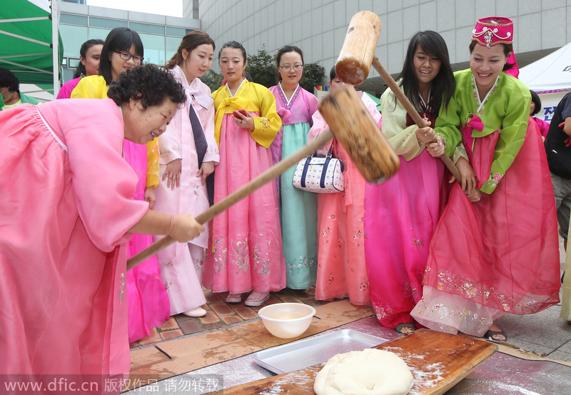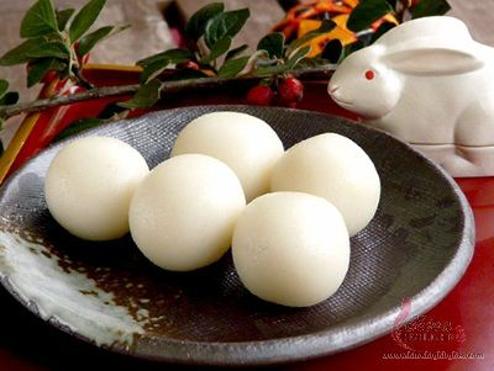
Mid-Autumn Festival, known as Chuseok in South Korea, is a major harvest festival and a three-day holiday in the country celebrated on the 15th day of the 8th month of the lunar calendar. As a celebration of the good harvest, Koreans visit their ancestral hometowns, share a feast of traditional food, such as songpyeon and rice wines, dance together or enjoy the moon. The picture taken on Sept 10, 2013, shows women in traditional costumes experience the making of songpyeon during the festival in Seoul. [[Photo/IC]
Vietnam
In Vietnam, Têt-Trung-Thu (tet-troong-thoo) or the Mid-Autumn Festival is one of the most popular family holidays. It is held on the 15th day of the 8th lunar month.
Vietnamese families plan their activities around their children on this special day. In a Vietnamese folklore, parents were working so hard to prepare for the harvest that they left the children playing by themselves. To make up for lost time, parents would use the Mid-Autumn festival as an opportunity to show their love and appreciation for their children.
Appropriately, the Mid-Autumn Festival is also called the Children’s Festival. In the United States, this tradition continues in many Vietnamese-American communities. Trung-Thu activities are often centered around children and education. Parents buy lanterns for their children so that they can participate in a candlelit lantern procession at dawn. Lanterns represent brightness while the procession symbolizes success in school. Vietnamese markets sell a variety of lanterns, but the most popular children’s lantern is the star lantern. Other children’s activities include arts and crafts in which children make face masks and lanterns. Children also perform traditional Vietnamese dances for adults and participate in contests for prizes and scholarships. Unicorn dancers are also very popular in Trung-Thu festivities.
Like the Chinese, Vietnamese parents tell their children fairy tales and serve mooncakes and other special treats under the silvery moon. A favorite folklore is about a carp that wanted to become a dragon. The carp worked and worked and eventually transformed itself into a dragon. This is the story behind the mythical symbol, Cá hóa Rông. Parents use this story to encourage their children to work hard so that they can become whatever they want to be.
There’s also a story about how the Moon Lady ascended to the moon. A man named Chu Coi found a lucky tree that had special healing powers. Because this tree was sacred, people were forbidden to urinate at the foot of this tree. Unfortunately, Chu Coi’s wife, Chi Hang forgot the rule and urinated on the tree. On day, while she was sitting on the tree’s branch, the tree started to grow and grow. Eventually, it reached the moon, Since then, Chi Hang lived on the moon for the rest of her life as a punishment for desecrating the sacred tree.
Japan

The Mid-Autumn Festival is named Tsukimi (月見) or Otsukimi (literally means moon-viewing) in Japan. Celebrations of the festival take place on the 15th day of the eight month of the traditional Japanese Lunisor calendar (usually takes place in September of the solar calendar)
The Tsukimi custom or moon-viewing custom originated from the Chinese Mid-Autumn Festival. Custom of viewing the moon and holding festival parties appeared over 1000 years ago when tradition of the Chinese Mid-Autumn Festival was introduced to Japan.
Unlike the Chinese, who eat mooncakes to celebrate the festival, the Japanese usually eat eating rice dumplings called Tsukimi dango. The tradition is now so popular in Japan that some people repeat the activities for several evenings following the appearance of the full moon during the eighth lunisolar month.
Israel
Succoth is the Jewish Harvest Festival. It begins on the 15th day of the Hebrew month of Tishri. It is usually held in September and October. This year’s Succoth begins on the eve of October 1. The celebration lasts for 7 days.
Succoth traditions and customs have both historical and religious significance. This festival dates back to the period during which Hebrews wandered in the wilderness on route to Canaan (now Israel). During their pilgrimage, they lived in temporary booths. This open living space is called a succah. People also gathered in sukkot (pleural for succah) to worship and share meals. Thus, Succoth is also called the Feast of Tabernacle. During harvest time, farmers also lived in sukkot in open fields. During Succoth, farmers take this time to thank God for the crops.
Today, modern Jewish communities continue the traditions of building sukkot and holding festivities inside them. For kids who love camping in the outdoor, this is a lot of fun. The roof of a succah is built with olive and other tree branches. The branches are decorated with fruits and flowers. Three sides of the succah are covered with blue and gold fabric. For those who need some help, you can also buy a complete succah kit . During Succoth, a special ceremony is held each day to remember Hebrew ancestors and to thank God for the harvest. Families gather for meals and sleep inside them as well.
India
Pongal is a popular harvest festival in South India. Named after a sweet rice dish, Pongal starts on January 14 of each year. The celebration lasts for three days. On the first day, Pongal is offered to Bhogi or Indran (the rain gods) for providing rain for the harvest. On the second day, pongal is offered to the sun (Surya). On the third day, the family’s cattle (mattu) is cleaned and dressed up with flowers, bells, and color powder. This is the day to honor the cattle’s hard work for plowing the fields.
Festivities vary in different regions. Some families clean their houses and throw away old clothes. But the main activity involves people from the entire village. Neighbors get together for a community feast to share their crops and give thanks to all who have contributed to a successful harvest.
Ghana and Nigeria
The Yam Festival is usually held in the beginning of August at the end of the rainy season. A popular holiday in Ghana and Nigeria, the Yam Festival is named after the most common food in many African countries. Yams are the first crops to be harvested. People offer yams to gods and ancestors first before distributing them to the villagers. This is their way of giving thanks to the spirits above them.
USA
Thanksgiving is truly an American holiday took place during the autumn. Celebrated by many religious and ethnic groups in the United States, Thanksgiving is held on the 4th Thursday in November. It is the time to give thanks, as in its name, for everything that has given to us.
The Thanksgiving holiday commemorates the first harvest celebrated by the pilgrims about 400 years ago. The settlers take this time to thank God for the crops and their first year in the new land.
